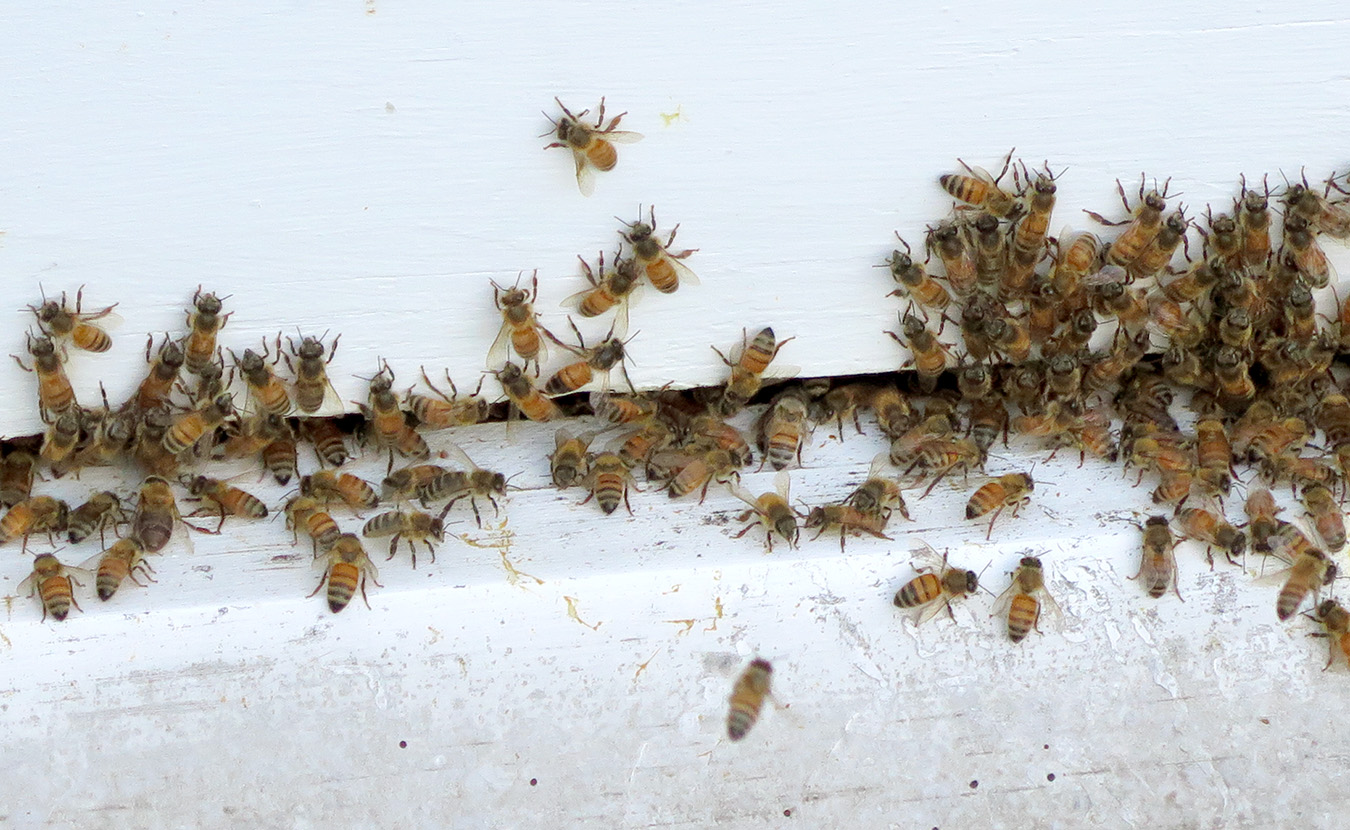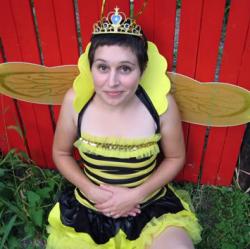By now you’ve surely heard that honeybees are in trouble. Doe-eyed TV newscasters have been proclaiming Beemageddon since the mid-2000s when entire hives of bees began vanishing without a trace. But, despite the doom and gloom, managed honeybee colonies are thriving in Bloomington and throughout Monroe County. Bees still buzz in and out of WonderLab’s downtown observation hive and from hives at the Bloomington Community Orchard, Indiana University’s Hilltop Garden and Nature Center, and backyards like mine.
It’s Complicated
What became known as Colony Collapse Disorder (CCD) still gets loads of media attention, as it should. However, that coverage is often oversimplified. It has been suggested, for instance, that honeybees are headed for imminent extinction, and every last fresh fruit and vegetable will go away with them. Things aren’t so cut-and-dried though. It’s true that honeybees are expert pollinators, and we’ve come to rely on them to produce nearly 100 different crops, including almonds, apples, melons, and avocados. But honeybees aren’t North America’s native pollinators. Before honeybees were imported, bumblebees, squash bees, mason bees, butterflies, moths, beetles, and even some birds did our pollinating — and still do!
As it happens, our native bee populations are in at least as much trouble as honeybees are. (Maybe even more.) Because many native bees live by themselves or in very small colonies, they’re much less practical for humans to manipulate or exploit like we have the honeybee. As a result, native bees haven’t gotten nearly the media attention — or research dollars — they deserve, and we’ve seen wall-to-wall coverage about honeybees and CCD instead.
A beekeeper since 2012, Wayne Justice tends five hives in Monroe County and, he notes, “In my personal experience, I have never lost a colony to CCD. Unfortunately, I think the uninformed public mistakenly classifies any colony death as CCD.”
But let’s pretend honeybees really did go poof! We’d still have fruits and vegetables, but certain crops might become scarcer and much more expensive. Truth is, we’ve already been paying more for some types of produce as a result of declining honeybee populations and the higher cost of pollination services.
Incidentally, honeybees that are part of the large-scale pollination circuit are subjected to thousands of miles of travel. Hives are driven from state to state, and bees are potentially exposed to all manner of pathogens and agricultural pesticides along the way. Instead of a single cause, CCD may be the result of a perfect storm of factors associated with overtaxed, stressed-out bees.
Plenty of things can doom honeybees, from naturally occurring diseases to predators and parasites such as the Varroa mite. Low nectar flows in summer or fall can lead to insufficient honey stores and winter starvation. Add a harsh winter to the mix, and you see it’s not easy being a bee.
Carolyn Peepall, a local beekeeper and president of Bee Town Bee Club, says area bees contend with chemical residues, too. “Certainly, when hives are placed close to crops, there is a drifting effect that may attribute to colony death. Some of our members have been using Drift Watch to register hives and track the effect of drifting chemicals,” she explains.
Since 2006, the Bee Informed Partnership, in conjunction with the Apiary Inspectors of America and the U.S. Department of Agriculture, has surveyed U.S.-based beekeepers about their annual colony losses. Respondents have included hobbyists, “sideline” beekeepers, and large-scale commercial operations. Preliminary results for the 2014–15 survey suggest winter losses of 23.1 percent of all managed honeybee colonies in the U.S. That’s down 0.6 percent compared to the previous winter. According to the Bee Informed Partnership, “This is the second year in a row the reported colony loss rate was notably lower than the nine-year average total loss of 28.7 percent.” Even so, 2014–15 losses for Indiana-based beekeepers came in at a whopping 49.1 percent.

Susan recommends creating a bee bath to give honeybees easy access to fresh water. | Photo by Susan M. Brackney
What You Can Do
Want to help Bloomington’s bees? Use pesticides sparingly, or, better still, avoid them altogether. If you insist on applying a chemical, never spray blooming plants, including weeds.
And, speaking of weeds, that “perfect” weed-free lawn is actually part of the problem. Go ahead and raise the deck on your lawnmower a smidge to let the clover and dandelions thrive. Both are invaluable sources of nectar and pollen.
Adding native, perennial flowers to your landscape will also put more on the menu for bees. But before you buy a single packet of seeds or tray of bedding plants, you need to be certain they’ve not been treated with pesticides — especially neonicotinoids.
Sadly, by planting “pollinator-friendly” stock from national chain stores, many gardeners may have unknowingly done bees more harm than good. A 2014 study conducted by Friends of the Earth U.S., the Pesticide Research Institute, and SumOfUs revealed high concentrations of neonicotinoids in soft-stemmed, flowering plants purchased from Home Depot, Lowe’s, and Walmart garden centers in 18 cities throughout the U.S. and parts of Canada. An independent, accredited lab found neonicotinoid contamination in more than half of the 71 samples of buds, flowers, stems, and leaves they analyzed.
That’s extra troubling, because contaminated plants — and plants grown from neonicotinoid-impregnated seeds — can continue to exude neonicotinoids via pollen and nectar for months and even years after the insecticide was originally applied. High levels of these insecticides kill bees, but lower neonicotinoid levels still take their toll — suppressing bees’ immune response and affecting their ability to navigate, learn, and forage.
They may cost a little more, but if you really want to help insect pollinators, you’ll choose organically grown plants and untreated seeds from trustworthy, certified organic vendors. Also, whenever possible, you should choose heirloom varieties over those flashy hybrids. As plant scientists monkey with Mother Nature — maybe selecting for more vibrant colors or doubled blooms — something, invariably, is lost. Often, that “something” happens to be the amount or quality of the hybridized plant’s nectar or pollen.
When looking into different varieties, consider when (and for how long) they’ll bloom. Ideally, you want to have something in bloom nearly year-round. (See “Susan’s Honeybee Garden Plan” for ideas.) Finally, besides deciding exactly what to plant, you’ll need to think about how much of everything to plant. (Hint: when you think you have enough, plant more!) Bees of every stripe use floral scent trails to find food. To make detecting these scent trails easier — and to counteract the effects of air pollution and our increasingly fragmented landscape — you should group individual flower varieties together in their own large, dedicated sections.
In addition to having safe sources of pollen and nectar, honeybees need fresh water. You can create the perfect watering hole for foraging bees by filling a ceramic saucer with rocks, marbles, or pea gravel (to give visitors better footing) and keeping it full of water. It might take a little time for area bees to accept your “bee bath” — particularly if it is too clean. Just let your saucer and its contents get nice and mossy, and the bees will come.
Not the gardening type? You can also help area honeybees by supporting their keepers. That means purchasing local honey from the Bloomington Community Farmers’ Market, Bloomingfoods, or other grocers’ “local” sections.
There’s another way you can help pollinators of all kinds. Check out the Saving America’s Pollinators Act of 2015, sign this online petition, and request your representative’s support.




